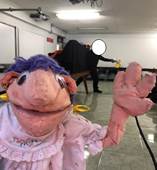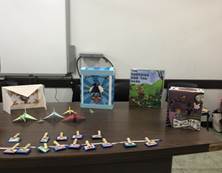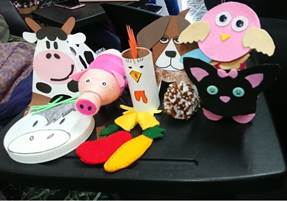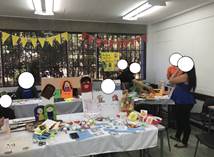Introduction
During the second cycle in 2018 (July to November), an experience of curricular integration was developed between the courses of Children’s Literature and Didactic Resources and Materials; both courses belong to the Bachelor’s Degree in English Teaching for elementary school, from Universidad Nacional (UNA). This joint work aimed to promote English throughout the implementation of literature along with the use of didactic resources and materials; this process intertwined varied literary texts and addressed them with different didactic resources and materials, so English was encouraged and fostered in a creative and engaging way.
As this curricular integration process was developed, literature and distinct tasks were integrated so that the students’ learning process was boosted and enriched from a theoretical and practical view. The course of Children’s Literature aimed to analyze and work on literary texts as a resource for teaching English in a communicative, creative, dynamic, and engaging way. On the other hand, the course of Didactic Resources and Materials for the major of English Teaching for elementary level aimed students to learn about the elaboration of various didactic resources and materials based on the integration of the four macro-linguistic skills: listening, speaking, reading, and writing. As a result and based on the fact that literature is commonly overlooked in foreign language classes given its complexity and time constraints, in this course, scenic, plastic, and musical skills were also intertwined to provide learners with the opportunity to create and generate resources and materials to help their future students gain insights in regards to literature and by having these materials as a source of information to rely on. This study presents a critical and deep analysis of the work carried out and the students’ perceptions in terms of their own experiences while taking both courses simultaneously, over the same school cycle.
Theoretical framework
What was the pedagogical foundation?
When dealing with language learning, pedagogy certainly sets the foundations for conceptualizing, reshaping, and executing the mediation process. As a result, it is always recommended to study and review this approach to teaching not only to keep in mind its theoretical principles, but also, to analyze the practices that can be changed, improved, and/or modified to provide learners the most appropriate educational environment and class context. Additionally, pedagogy, undoubtedly, shapes the instructors’ actions and leads their praxis throughout time; however, as it is known, education is an ever-changing phenomenon that closely reflects cultural, political, and social contexts and that is highly influenced by policies related to the prior settings.
From this perspective, this article aims to describe how the pedagogical praxis of the courses Children’s Literature and Didactic Resources and Materials was developed; both aimed to explore the importance of working with diverse literary texts along with resources and materials for fostering English as the students’ target language, and how this process contributed for the research participants in terms of their experiences and self-perception. In fact, learners were able to choose their preferred literary text and to select the material or didactic resource they desired to create, so pedagogy was conceived from a critical viewpoint from where learners were «free»1 and encouraged to «think by themselves»1.
Moreover, when instructors believe and work under the principles of critical pedagogy, they welcome the opportunity of addressing the class by considering equality, gender, human rights, among other aspects that pertain to any human being. Brown (2000)2 affirms that when working with critical pedagogy, the following principles and examples are useful for fully respecting students’ beliefs and values:
Allow students to express themselves openly (be sensitive to power relationships, encourage candid expression).
Genuinely respect students’ points of view (seek to understand their cherished beliefs and traditions).
Encourage both/many sides of an issue (welcome all seriously offered statements, opinions, and beliefs).
Don’t force students to think just like you (delay or withhold your own opinion).
For the development of both courses, critical pedagogy was the foundation for the pedagogical praxis carried out, and it was essential for: promoting active participation, expressing varied points of view, encouraging discussion, and working around the students’ interests, beliefs, and values in terms of literature and their creativity for designing different didactic resources and materials. The professors of both courses worked as facilitators, who guided learners during lessons, but who firmly believed input was necessary for students to take action once they had made enough connections between their previous knowledge and the new one.
How was the curriculum integrated?
Curriculum integration, according to Wall and Leckie3, «advocates for curriculum that is exploratory, relevant, integrative, and meaningful to learners»; in the case of the students, who were registered in the Bachelor’s for English Teaching for elementary school, it is essential to work on different activities to find sense in their performance, relationships between courses, objectives, and contents, in order to make the most out of the educational act. Even so, the meaning of curriculum integration varies; it is essential to point out that it «involves meaningful learning organized around issues important to teachers and students»4. In this specific case, the competences expected from pre-service teachers to achieve, and the organization of the courses become an opportunity to explore a wide range of possibilities for the use of literature and didactic materials and resources created around the themes developed in the literary texts selected; allowing essential components to emerge such as the creativity, leisure, and recreation while learning English as a foreign language (EFL).
Why should literature be implemented in the language class?
In Costa Rica, English is taught as a Foreign Language (EFL) in all school levels, from preschool up to high school; this takes place in the public as well as in most private systems5. After a research developed by the Costa Rican Ministry of Public Education (MEP), the English program changed radically, complementing the Communicative Language Teaching (CLT) approach used previously with the Action-Oriented (AO) approach, so, in 2016, MEP started implementing the new program gradually. This program demands English teachers to be certificated with a B2 or C1 in their language proficiency, according to the Common European Framework of Reference (CEFR), but it also requires the development of certain abilities that will allow students to demonstrate their English language abilities through tasks. A task varies in nature, but it mediates learning, and its accomplishment involves: …the strategic activation of specific linguistic competences (linguistic, pragmatic, and socio-linguistic) along with a range of socio-cognitive competences in order to carry out a set of purposeful actions in a particular domain (interpersonal, transactional, academic and professional) with a clearly defined goal and a specific outcome6.
Based on the previous quotation and on what the Action-Oriented approach (AO) demands from students and even teachers, in terms of task performance, the development of the reading and speaking skill is the means to achieve the proposed goals. From this standpoint, the courses of Children’s Literature and Didactic Resources and Materials aimed to promote curricular integration by addressing English through literature and distinct resources. This process was carried out by emphasizing on the importance of using the target language where different macro-skills were addressed through an implicit approach. As a result, learners’ work was focused on the content rather than on specific linguistic aspects, as it was years before; from 2005 up to 2016, when MEP’s syllabus was changed.
Indeed, in Costa Rica, in the public system, specifically, classes are usually focused on the linguistic aspects of the language, and instruction, most of the times, is carried out through an explicit approach, which, in some occasions, overlooks the value of implicit pedagogical practices, which may also benefit students through a more creative and meaningful way of learning, as it is the case of literature use along with didactic resources and materials for promoting the learning of English. Teaching literature in the language class is unquestionably not an easy task; nevertheless, it may be an exceptional ally for helping students become acquainted with a wide variety of grammatical structures, idioms, conventions, types of register, vocabulary, and even cultural aspects of the target language.
In this regard, Chambers and Gregory7state that when teaching literature, instructors should make sure they provide learners with opportunities to:
learn to read a range of primary texts genres appropriately -in breadth and depth- engaging in associated processes of textual analysis, interpretation and evaluation;
engage with the concepts and networks of ideas that characterize literary discourse, and learn to think in terms of them;
grasp the assumptions and purposes that underlie debates (theoretical-critical) within the discipline along with the beliefs and values that inform them;
understand the way argument is conducted within literary discourse, what counts as evidence and how it is used;
learn to speak and write within the conventions that apply;
take an independent, critical stance to study.
From this stance, literature should be promoted from early stages in the English class, so students become acquainted with the target language and go beyond the class’ contents by having the possibility of exploring different literary texts, materials, and resources and by gaining insights related to grammar, culture, vocabulary, etc. implicitly. Moreover, literature also enables learners to broaden their knowledge in terms of varied topics and promotes the ability of exchanging ideas and opinions based on different subjects. Literature is a vast field of language, which, sometimes, turns out to be challenging for language educators; however, if used effectively in the classroom, teachers as well as students can enjoy its magic. Besides that, literature not only fulfills and integrates the four linguistic macro-skills and covers several language micro-skills, it also deals with culture and in turn, with the understanding of social and human ways of living of the target language. Learning a language certainly involves culture; thus, literature is a helpful ally for encouraging learners to relate to the target language in a meaningful, purposeful, and thoughtful way. In addition, Keshavarzi affirms that «language is associated with culture»8. That is, language is the carrier of cultural messages. As such, literature is very significant when employed in teaching a language. Literature is culture»8. In this regard, literature deals with culture and this demands learning how people communicate and understand others in the target language.
Why are didactic resources and materials relevant?
Didactic resources and materials can be defined as any physical or digital source of information used for educational purposes; they can be self-created or obtained in the form of educational-produced materials, textbooks, websites, among others. In fact, for the purpose of developing a well-designed pedagogical praxis, language educators must make informed decisions about the materials and resources they select for their lessons since they must be age and language-level appropriate. In addition, they must be contextualized and as closely related to the learners’ reality as possible. In this regard, Richards stated that
teaching materials are a key component in most language programs. Whether the teacher uses a textbook, institutionally prepared materials, or his or her own materials, instructional materials generally serve as the basis for much of the language input learners receive and the language practice that occurs in the classroom.9
As a result, it is essential that language instructors make sure their pedagogical praxis is based on the use of didactic resources and materials, which clearly match their students’ context, learning styles, and needs; their selection requires critical attention, so educated decisions can be made. For this study’s purpose, the research participants selected varied literary texts, and they designed materials and resources with a set purpose in mind, so they worked as a source of information to rely on while working on a given work of literature. In fact, Richards affirmed that «for learners materials may provide the major source of contact they have with the language apart from the teacher»10, which, in general, turns out to be true since students not just interact with their instructor but also with the resources and materials available in class, and they gain input from those sources too. Finally, Richards11 indicated that the advantages of creating materials lies in the fact that they will probably be directly linked to the target population’s context and needs; also, they will be flexible in terms of their use and further adaptation, if needed.
Methodology
Research approach
This research is based on a qualitative approach, which, according to Creswell is
constructivist knowledge claims, ethnographic design, and observation of behavior. In this situation the researcher seeks to establish the meaning of a phenomenon from the views of participants. This means identifying a culture-sharing group and studying how it developed shared patterns of behaviour over time (i.e., ethnography). One of the key elements of collecting data is to observe participants’ behaviors by participating in their activities.12
In fact, this study is based on the research participants’ experiences and perceptions while taking part in two courses, which main objective was to foster English as the target language through the use of literature and the implementation of varied didactic resources and materials. As a result, during the pedagogical mediation of the Children’s Literature and Didactic Resources and Materials courses, the linguistic as well as the pedagogical fields were joined to promote a dynamic and participatory experience for the students of this research. For this purpose, theoretical as well as practical foundations were essential for the mediation process.
In addition, in the course Children's Literature, various concepts, methods, and techniques were put into practice for the introduction, development, and use of children's literature in the target language, which was one of the courses’ main objectives since they aimed to foster the learning of English as a foreign language through literary texts. According to the syllabus for English Teaching for elementary school, the Children's literature’s course stated that
Literary text is visualized as a creative use of language, which can stimulate the acquisition / learning of structures and vocabulary, as well as the development of communication skills, creativity and imagination of the child. The application of various techniques for the use of literary texts in the classroom, as well as the adaptation of literary texts will be the practical dimension of literature.13
In fact, in the course of Children’s Literature the following thematic areas were addressed:
The role of literature in learning a foreign language; use of imagination in the acquisition process.
Children's literature: definition, genres, terminology, their role in child development, and their role in the foreign language classroom.
Techniques for the introduction of texts in the classroom; motivation and encouragement for reading; the reading process: pre-reading, reading, and post-reading.
Story telling.
The previous themes were the ones specifically addressed in the curricular integration process; they were selected by the researchers in order to organize and develop the different pedagogical actions developed during the cycle.
Type of study
This study is based on the students’ experience taking part in the curricular integration process of the courses Children’s Literature and Didactic Resources and Materials, which main purpose was to develop meaningful experiences in regard to the development of literature along with the use of didactic resources and materials. The participants’ experiences and perceptions were gathered, so their views worked as the primary source for analyzing the data collected and for developing the triangulation process. In addition, this was a case study; Creswell’s14defines it as a qualitative approach in which the investigator explores a real-life, contemporary bounded system (a case) or multiple bounded systems (cases) over time, through detailed, in depth data collection involving multiples sources of information (e.g., observations, interviews, audiovisual material, and documents and reports), and reports a case description and case themes.
This research aimed to explore deeply a particular bounded system, case, in which specific data from the participants was collected to analyze in detail their experiences and perceptions towards the implementation of literature along with the use of varied didactic resources and materials. For this purpose, students worked with distinct literary texts and materials for the design and creation of the corresponding pedagogical resources.
Context and participants
This study took place in Universidad Nacional (UNA), Costa Rica, specifically, in the bachelor’s degree of Teaching English for elementary school, in the courses of Children’s Literature and Didactic Resources and Materials. At the moment of this study, the participants were taking both courses simultaneously, but in different schedules, over the same II cycle, in 2018, and they were active participants throughout the whole process. This student population was taking their second year of the major and their ages ranged from 19 to 30 years old. These learners were able to communicate in the target language accurately and fluently, according to their level. At this moment, students had already taken fourteen courses from the linguistic area, in which they learned how to communicate in the target language and eight courses from the pedagogical component, which were mostly taught in English too.
It is also relevant to mention that students took both courses, Children’s Literature and Didactic Resources and Materials, in English. Besides that, for this specific study, gender was not a variable of interest. On the other hand, the key element about these students was their process of taking both courses over the same academic cycle and their active participation in class. This process is defined by Creswell15 as «purposeful sampling», which refers to the intentional selection of individuals and contexts to comprehend a main phenomenon. Additionally, according to Richards16, there are several options available for syllabus design, which, in turn, is translated into the pedagogical mediation developed. In this case, for the aforementioned courses, it was task-based since the mediation praxis was «organized around different tasks and activities that the learners would carry out in English», so literature and didactic resources and materials were implemented simultaneously.
Instruments
During the pedagogical mediation of the courses Children’s Literature and Didactic Resources and Materials, information was gathered through three techniques: observations, journals, and an open-ended questionnaire. Data was specifically gathered based on two categories a) literature as the means for promoting English as a foreign language and b) didactic materials and resources as the mechanism for addressing literary texts through a creative, dynamic, engaging, and innovative way.
These observations were carried out over twelve weeks (one day per week) during class time; these were useful to collect information related to the implementation of literary texts for promoting English and the use of varied didactic materials and resources. According to Creswell17, there can be different observational roles in a research; for the purpose of this study, the role of a participant observer was performed since the professors of both courses were involved in the activities carried out at the research setting. This experience offers valuable opportunities for the observer to gather information about the participants’ views and experiences. Creswell18 stated that "a participant observer is an observational role adopted by researchers when they take part in activities in the setting they observe. As a participant, you assume the role of an "inside" observer who actually engages in activities at the study site".
Moreover, lessons were particularly designed and planned to promote the implementation of diverse literary texts through the use of didactic resources and materials, which were created based on the selected passage. Students learned how to design physical as well as digital didactic resources and materials with the main objective of supporting their process while telling a specific fairytale, legend, story, among other kinds of literary texts. Another way of collecting information for this research was the journal. Every two weeks each student would write a journal, where they could share a) some thoughts related to the content covered in the courses and b) the way they could reflect on how they visualized the relationship among topics, actions, and so on from both courses. Every two weeks, students had around 10 minutes during the class to work on their journals, and during the last session, instead of writing on the journal, some time was given for learners to go over their own interventions and share their main findings with the rest of their classmates. The results of the journals were developed in this way, so students had the freedom to react to the pedagogical actions taken in the two courses in the way they preferred, without feeling judged or evaluated by the professors.
Implementation
For this study, the professors in charge of the courses Children’s Literature and Didactic Resources and Materials carefully designed and planned both syllabuses in order to make sure there was a coherent and consistent curricular integration, so the pedagogical mediation was developed smoothly and by following these actions:
Allowing students to choose a book of their preference.
Being part of different sessions of storytelling.
Participating in class demonstrations where a story was the base of a lesson plan to develop specific content.
Participating in two workshops: a) with a puppeteer who invited the students to experiment with a puppet in front of the class, and b) in the elaboration of a Kamishibai (Japanese theater) to tell a story based on images.
Besides the aforementioned actions, as a complementary task, in figure 2, it can be observed that students chose a story and designed a game box where children could read the book, answer questions related to the plot, characters, and work on different games planned for them to assess their comprehension of the literary text.
Results and Discussion
Over the development of the Children’s Literature course, students learned the role of literature in terms of language learning and why it is essential for this process. They analyzed why imagination plays an important role when working with varied literary texts; they experienced the different literary genres, their terminology, function, and the children’s development while learning the target language. During lessons, the professor of the course selected distinct texts and introduced them to students, so they reflected on the importance of motivation and stimulation pre, while, and post-reading. Also, elements such as illustrations in literary texts, the art of narrating, selection of texts, reading activities (silent and out-loud reading) were addressed. Students realized that through literary texts and the elaboration of diverse didactic materials, their future students may be able to learn a foreign language in a more meaningful way. Students worked on varied class activities such as narrating fairy tales and stories, performing role-plays (characters), development
and enhancement of linguistic skills, work on puppets, and study of the different sections of a story; for instance, characters, setting, plot, point of view, and moral of the story.
At the end of the process, an open-ended questionnaire was applied to gather information related to the students’ perceptions in terms of the use of literary texts for promoting the learning of English as a foreign language. This process was tightly linked to the use of varied didactic resources and materials particularly designed for this purpose. All the participants of the study affirmed that literature is certainly useful for learning and teaching English since they believe that it is a creative and dynamic way of having their target population, not only learn about different literary texts, but also to have the opportunity of learning some other linguistics aspects such as grammar, expressions as well as idioms, and vocabulary in a contextualized, implicit, and meaningful way. This finding matches what Keshavarzi stated
Literature helps in incorporation of linguistic competence into communicative competence by putting language into use in different social situations. Literary texts, especially short stories, provide teachers and learners of English with a lot of pre-reading and post-reading activities, the ones which stimulate the learners’ imagination and results in their creativity. Even after a long time, these activities remain with the learners as they try to remember the incidents of the story and the way they predicted them to happen.19
Moreover, when literature is used in the English class, cultural aspects are taught as a way of having learners gain insights in terms of the existent connection between language and culture; from this standpoint, Erdem20 affirms that «learning a language means getting familiar with the culture, geography and socio-economic structure of the targeted language. It is important to know the history of the people, their traditions, customs and values for better communication», which, unquestionably, matches this research study’s purpose.
The participants of this study also mentioned that the use of didactic resources and materials; either in physical or digital format, are essential for promoting literature in the English class since they are practical and useful for supporting the process and for having students follow the ideas presented in a dynamic and engaging way. Additionally, as it can be observed in figure 3, students were also asked about the physical didactic resources and materials they consider effective and functional for teaching literature; they stated the following: flashcards, bingo games, board games, word search, theater-stages and puppets, kamishibai (Japanese technique), big books, memory games, filling in the blanks worksheets (images have to be closely observed, so the corresponding word is included in the blank), crosswords, and role-plays.
In regard to figure 4, the participants indicated that digital materials and resources such as flashcards and/or images, jeopardy, Kahoot games, memory games, QR codes, videos, web quests, and «who wants to be a millionaire» games are valuable and practical for teaching literature since these types of resources keep the target population engaged, which helps learners be focused on the literary text and what is discussed over this learning process.
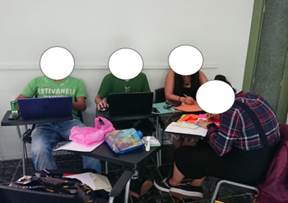
Source: Picture taken by Priscilla Carranza, 2018.
Figure 4 Students working on the creation of digital as well as didactic resources and materials
During the different sessions, students started sharing ideas and thoughts related to the stories read and used for the activities planned and also the way they could elaborate material for them. By the end of the cycle, students showed more enthusiasm about the act of reading, so in an indirect way, reading as a leisure activity was promoted and the stories were looked at as a useful tool for promoting language learning.
Finally, it is important to mention that the participants of this study, as part of the courses’ assignments, had to implement a set of physical and digital didactic resources in an English context in the second cycle (fourth, fifth or sixth grade); they were able to choose the level and a public elementary institution. Over the cycle, students created didactic resources and materials based on specific literary texts, so they could experience being in a class and implementing their selected text and designed material and/or resource. From this viewpoint, Richards and Renandya asserted that
Real communication, however, implies the engagement of genuine interest and will depend, in part at least, on the presence of a positive group dynamic in the classroom. The input from the materials provides linguistic and cultural preparation before, or in parallel with, the learner-generated language which is the ultimate goal of the learning process.21
As a result of the process carried out and based on that premise, the research participants aimed to have an engaging dynamic in which the literary texts were implemented along with the use of the created didactic resources and materials, so the population who was part of the class received input in their literature-session and used the target language to communicate their ideas and opinions in regard to the information presented and studied. The participants of this study regarded these experiences as truly beneficial and useful since they gained insights from their target populations in terms of literature and the materials and resources designed.
As shown in figure 5, learners pointed out that the use of physical didactic resources and materials was more convenient and practical since they were able to take to class everything they needed for working with the literary text. They stated that most classrooms lack the minimum conditions for using digital didactic resources, which delayed the process while they figured out how to make the Internet connection work or even how to get a computer which was able to run the program they used for creating and designing a specific resource for the chosen literary text.
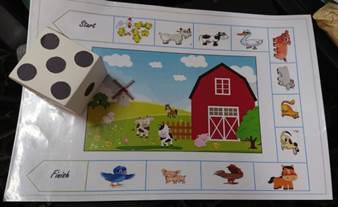
Source: Picture taken by Priscilla Carranza, 2018.
Figure 5 Sample board game (physical didactic resource) designed for addressing a literary text
As seen in figure 6, this process evidenced that students truly felt more confident when they used physical didactic resources and materials; also, they pointed out that the process seemed to flow more smoothly and their target population gave them the impression of enjoying the process of making a circle, sitting on the floor, listening to the fairy tale or story, and then working with the created and designed didactic resource and material. This sequence of micro-practices helped the participants resemble a literature-based class in which students were learning English dynamically. Learners also mentioned that their target population showed high interest and motivation towards the literature time class and towards the use of the didactic resources and materials designed for that purpose.
Conclusions
Based on the development of the pedagogical praxis of the courses, it can be concluded that the participants of this study truly perceived the implementation of literature along with the use of didactic resources and materials as effective and helpful for promoting English. They affirmed that this practice of using literature in the language class kept their target learners more engaged and interested in the lesson, which was certainly a source of motivation during the pedagogical mediation. Besides that, students identified various didactic resources and materials as more effective when implementing literary texts since they could be easily handed and employed during the class, which is an essential element to consider given that the English lesson and/or lessons usually take from 40 to 80 minutes; so every activity has to be timed properly.
In addition, awareness in terms of the creation and design of didactic resources and materials was raised; students considered their target population in order to elaborate materials and resources that were appropriate in terms of colors, design, size, texture, and usefulness and relatedness to the selected literary text or texts. This process was carried out throughout both courses, and deep and wide analysis and discussion was developed to have students reflect critically towards the creation and design of didactic resources and materials. It is relevant to highlight that learners also had to examine cautiously the selection of the literary text, which, certainly, had to be age and language-level appropriate.
Moreover, students also learned how to identify and analyze the class conditions of their target population, so they could work on didactic resources and materials that could be used in their English lessons. The schools where students implemented literary texts along with the created materials and resources were public, so the conditions in terms of technological resources were usually limited, which, in some cases, turned their pedagogical mediation into a challenge since they had to solve the situation out in situ. Nonetheless, the participants of this study valued and considered fundamental learning how to design digital and online didactic resources since these insights and experience will certainly help them in their future pedagogical praxis. As a result, and based on those experiences, students came to the conclusion that, as future English teachers, it is always fundamental to carry out a meticulous analysis of the class conditions previous to any lesson, so they are able to plan their language class based on what is available in the educational context and by addressing their learners’ needs.
Regarding curriculum integration, the experience opened a whole world of possibilities to students; the actions developed in class were not just presented, they were also lived and enjoyed, becoming a meaningful experience that could be replicated in other educational settings. In terms of literature, students had the opportunity to be in contact with different literary works that became useful for fostering the target language learning process, and it also changed their opinion related to the act of reading; it became an enjoyable activity.
Formato de citación según APA
Carranza-Marchena, P. y Badilla-Zamora, I. (2022). Literature and Didactic Resources and Materials for Promoting English: Case Study Developed in 2018. Revista Espiga, 21 (44).
Formato de citación según Chicago-Deusto
Carranza-Marchena, Priscilla y Badilla-Zamora, Isabel. «Literature and Didactic Resources and Materials for Promoting English: Case Study Developed in 2018». Revista Espiga 21, n.º 44 (julio-diciembre, 2022).














